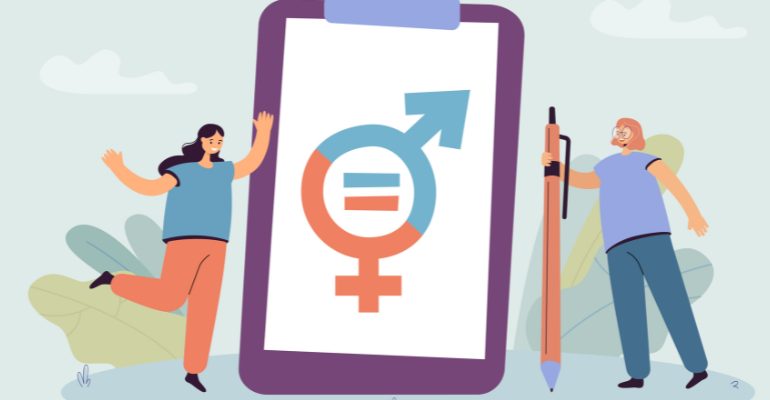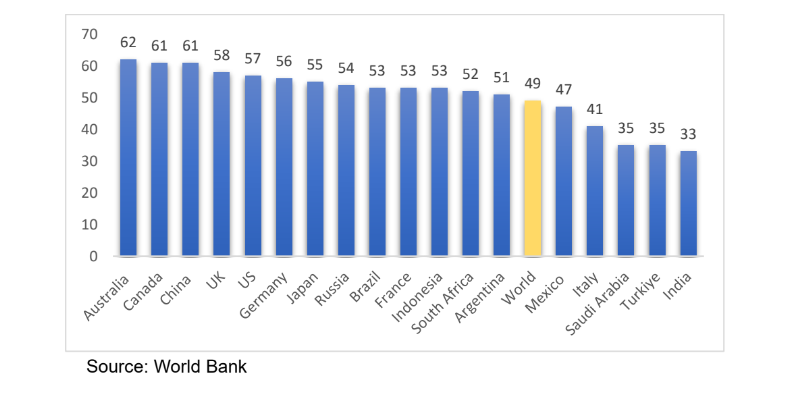Issue Briefs
Thematic Area: Capacity Building, Skilling, and Mobility

Closing the Gender Gap: How can education and skilling help?
Why is it important to close the gender gap?
Achieving gender parity continues to be a pressing issue worldwide. Women and girls across the world continue to face significant barriers in terms of access to education, skills training and healthcare, among others, and are under-represented at all levels of decision making. Further, societal and cultural norms exacerbate the prevalence of gender discrimination, resulting in unequal opportunities for work.
While there has been substantial progress on this issue in the last few decades, several challenges remain. The World Economic Forum (WEF) 2024 Global Gender Gap report estimated the global gender gap score at 68.5%, reflecting data for 146 countries. The gender gap improved by a margin of 0.1% since last year, indicating slow progress achieved in closing the gap.
While achieving gender equality is an independent Sustainable Development Goal (SDG), it is also a critical catalyst for achieving other SDGs. As more women work, economies grow, which in turn reduces economic inequalities. Promoting women empowerment also leads to significant economic gains and it is estimated that closing gender gaps could boost global GDP by USD 7 trillion.
Female Labour Force Participation Rate (% of female population aged 15+) in select G20 economies

However, significant differences continue to exist between male and female labour force participation rates, with the global average for women at 49% in contrast to 73% for men, as per World Bank data. As this can lead to reduced productivity gains and constrain economic output, there is need for urgent action from all stakeholders including governments and businesses to undertake proactive efforts to close the gender gap.
Promoting gender equality has also been identified as a key priority by G20 leaders. Women 20 or W20 is the G20 engagement group that focuses on promoting gender equity and women’s empowerment. The W20 group has urged G20 countries to implement policies that can enhance work opportunities and women’s participation across national and international markets.
Role of education & current gaps
Education is a key force that can promote gender parity by enhancing women’s labour force participation rates (LFPR) and building a more inclusive society.
As per World Bank estimates, it is estimated that every year of learning brings a return of around 9-10%. Studies also find that educated women are more likely to delay marriage, are more informed about nutrition and healthcare, have fewer children and invest more in their children’s health and education.
It is widely documented that a higher level of educational attainment is associated with significant reduction in gender related employment disparities. An ILO study finds that tertiary education leads to increased women’s labour force participation rates.
On the other hand, low educational attainment significantly restricts women’s opportunities for work. This problem is more severe in low- and middle-income countries. As per ILO’s World Employment and Social Outlook report, the Female LFPR in North Africa stood at 20% in contrast to 69% for men in 2023.
As highlighted by the 2023 OECD report on Gender, Education and Skills, gender gaps continue to persist across different levels of educational attainment. Further, gender imbalances across fields of study and career choices lead to more difficulties for women in finding appropriate and high pay job opportunities as compared to men. Specifically, significant gender gaps continue to exist in the science, technology, engineering, and mathematics (STEM) fields.
Role of skilling & current gaps
Skill development is another key factor that can significantly enhance women’s economic participation. Effective skill development and training programmes can facilitate women’s smooth transition into the labour market and bridge the gap between women and work.
By preparing women with a range of multiple and practical job skills, vocational education and training (VET) significantly raises productivity and has been found to have substantially raised earnings and overall employability of women. VET has also been proved effective in enhancing formal sector employment in low- and middle- income countries. Implementation of such training programmes is particularly important for the most vulnerable groups across the developing and less-developed regions as well as for those affected by recent geopolitical conflicts.
However, significant differences persist between male and female participation in training programmes along with fields of study choice. For example, it is found that men are more likely to participate short-cycle tertiary programmes in STEM fields. Additionally, females are less likely to participate in apprenticeship programmes as compared to men, often citing family responsibilities and high training costs as barriers.
With the advent of advanced technologies, the role of technical education and specialized skills training is equally important for equipping women with the necessary technical and digital skills to keep pace with the ever- evolving jobs landscape. As per WEF’s global gender gap report, gender disparities continue to exist in fields including AI and big data (30%), programming (31%) and networks and cybersecurity (31%).
Therefore, imparting the requisite technical skills, including digital skills to women is particularly important for addressing women’s underrepresentation in high paying and rapidly growing sectors such as technology,
What can governments and businesses do?
Concerted efforts are required from global policymakers and relevant stakeholders for fostering gender equality and bridging the gender gap. In light of the above issues, below are some actions that can help achieve the goal faster, with a strong focus on education and skill development.
- Bolster institutional support along with government collaboration with special focus on women enrolment across all levels of education including primary, secondary, and tertiary education.
- Targeted investments in girls’ education with a focus on a gender-equitable education system. Creating a safe environment for enhancing socio-emotional and life skills for girls is equally important.
- Establish vocational training institutes to equip women with requisite skills across a wide range of occupations. Provide financial and logistical support to cover indirect costs of training including childcare that can facilitate greater access to training programs.
- Offering short-term, online courses at affordable costs can also remove time and resource constraints and encourage greater participation of women in training programs.
- Offer apprenticeships and work-based learning opportunities for women across broader fields of study.
- Offer Technical and Vocational Education and Training (TVET) program to enhance skills and job creation targeted at women and most vulnerable groups in the post-conflict areas. This is particularly important in the aftermath of various geopolitical conflicts.
- Dedicated training institutes can be set up that offer specialized training to equip women with industry-relevant skills with special focus on technology, healthcare, entrepreneurship, and emerging fields including AI, data analytics, digital manufacturing.
- The above must be supported by universities and higher education systems devising appropriate policy measures to enhance women enrolment in STEM fields.
- Appropriate policies must be designed for business and entrepreneurship training for promoting women entrepreneurship along with improved access to finance and capital.
- The private sector can promote greater awareness on gender-neutral job evaluation methods along with skill-based assessments to determine the value of work.
- It is important to ensure the safety and security of women students at all places of learning and to keep a focus on the availability of local facilities tailored to local needs.
Governments and businesses around the world must come together and undertake specific actions and policies to enhance women’s education and skill development which will help close the gender gap and ensure the smooth transition of women in the future of work.
